As long as this current count of 750 military bases in 81 places remains a reality, so, too, will U.S. wars, writes Patterson Deppen.
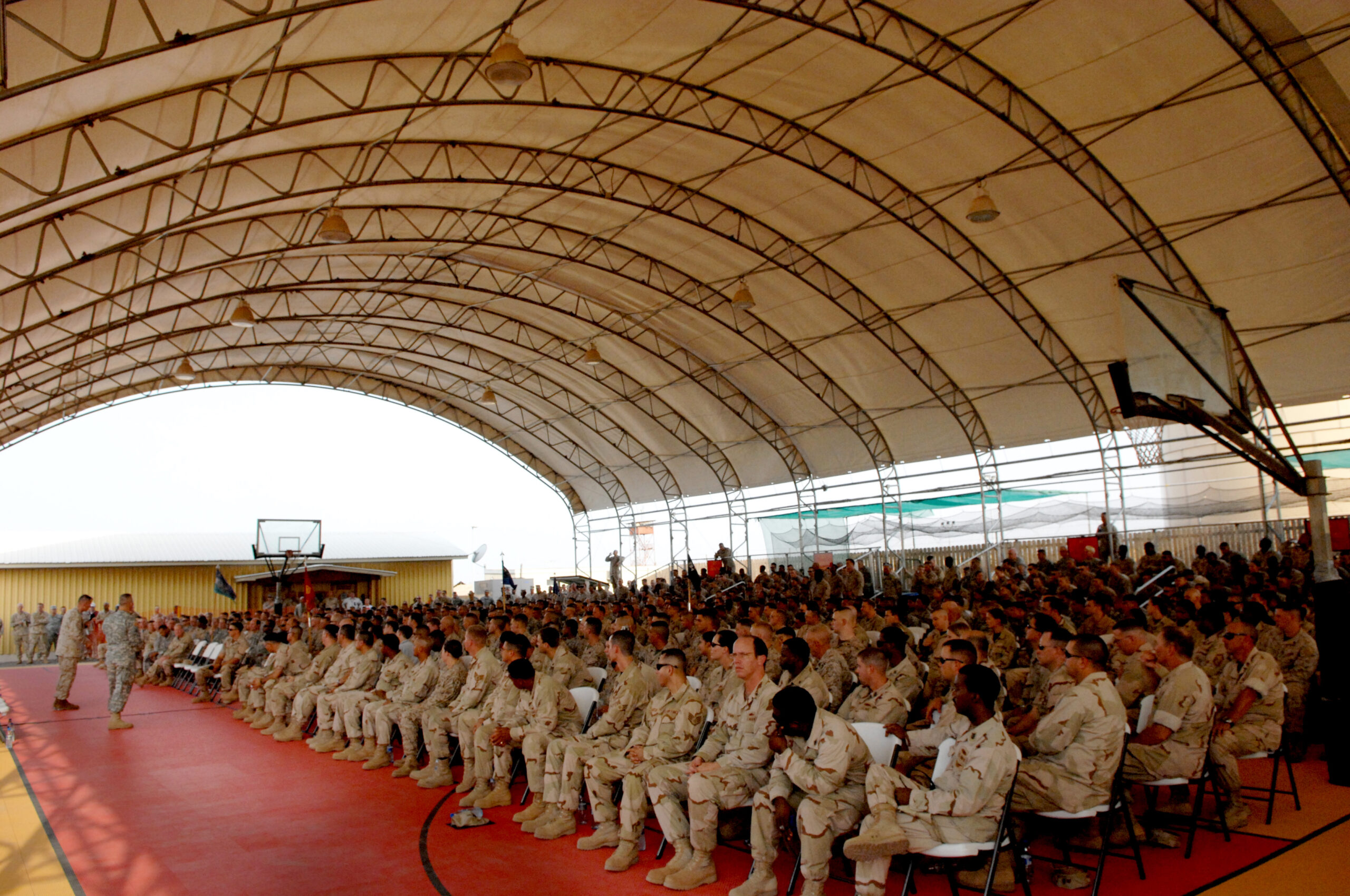
Aug. 14, 2007: Marine Gen. Peter Pace, chairman of the Joint Chiefs of Staff, conducts a town hall meeting with approximately 1,200 troops in the “Thunder Dome” at Camp Lemonier, Djibouti. (U.S. Air Force, Myles Cullen)
By Patterson Deppen
TomDispatch.com
It was the spring of 2003 during the American-led invasion of Iraq. I was in second grade, living on a U.S. military base in Germany, attending one of the Pentagon’s many schools for families of servicemen stationed abroad. One Friday morning, my class was on the verge of an uproar. Gathered around our homeroom lunch menu, we were horrified to find that the golden, perfectly crisped French fries we adored had been replaced with something called “freedom fries.”
“What are freedom fries?” we demanded to know.
Our teacher quickly reassured us by saying something like: “Freedom fries are the exact same thing as French fries, just better.” Since France, she explained, was not supporting “our” war in Iraq, “we just changed the name, because who needs France anyway?” Hungry for lunch, we saw little reason to disagree. After all, our most coveted side dish would still be there, even if relabeled.
While 20 years have passed since then, that otherwise obscure childhood memory came back to me last month when, in the midst of the U.S. withdrawal from Afghanistan, President Biden announced an end to American “combat” operations in Iraq. To many Americans, it may have appeared that he was just keeping his promise to end the two forever wars that came to define the post-9/11 “global war on terror.”
However, much as those “freedom fries” didn’t actually become something else, this country’s “forever wars” may not really be coming to an end either. Rather, they are being relabeled and seem to be continuing via other means.
Having closed down hundreds of military bases and combat outposts in Afghanistan and Iraq, the Pentagon will now shift to an “advise-and-assist” role in Iraq. Meanwhile, its top leadership is now busy “pivoting” to Asia in pursuit of new geostrategic objectives primarily centered around “containing” China. As a result, in the Greater Middle East and significant parts of Africa, the U.S. will be trying to keep a far lower profile, while remaining militarily engaged through training programs and private contractors.
As for me, two decades after I finished those freedom fries in Germany, I’ve just finished compiling a list of American military bases around the world, the most comprehensive possible at this moment from publicly available information. It should help make greater sense of what could prove to be a significant period of transition for the U.S. military.
Despite a modest overall decline in such bases, rest assured that the hundreds that remain will play a vital role in the continuation of some version of Washington’s forever wars and could also help facilitate a new Cold War with China.
According to my current count, our country still has more than 750 significant military bases implanted around the globe. And here’s the simple reality: unless they are, in the end, dismantled, America’s imperial role on this planet won’t end either, spelling disaster for this country in the years to come.
Tallying Up the ‘Bases of Empire’
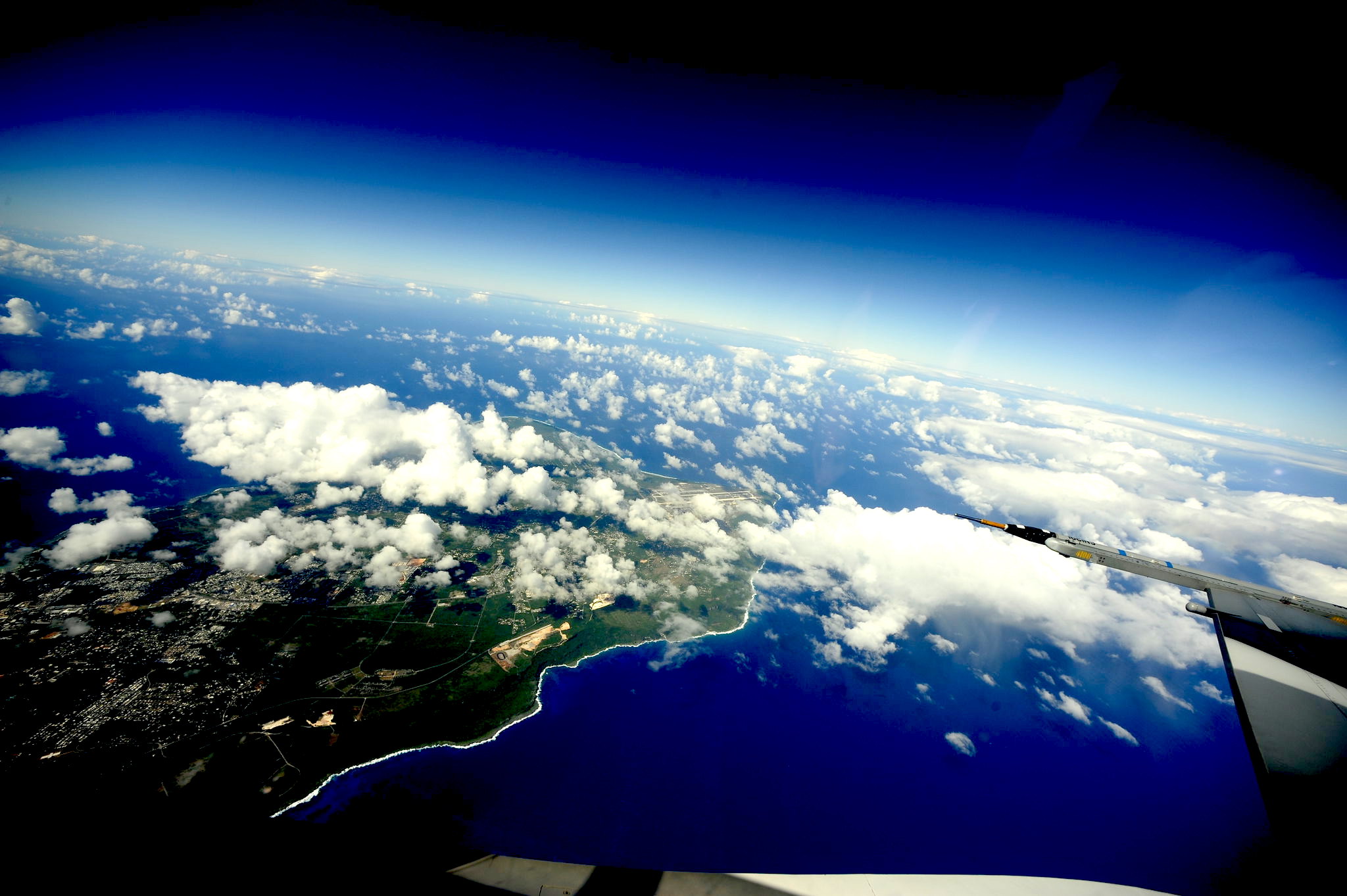
Andersen Air Force Base, Guam, photographed from a U.S. fighter plane during training in 2010. (DoD Inspector General, Flickr)
I was tasked with compiling what we’ve (hopefully) called the “2021 U.S. Overseas Base Closure List” after reaching out to Leah Bolger, president of World BEYOND War. As part of a group known as the Overseas Base Realignment and Closure Coalition (OBRACC) committed to shutting down such bases, Bolger put me in contact with its co-founder David Vine, the author of the classic book on the subject, Base Nation: How U.S. Military Bases Abroad Harm America and the World.
Bolger, Vine and I then decided to put together just such a new list as a tool for focusing on future U.S. base closures around the world. In addition to providing the most comprehensive accounting of such overseas bases, our research also further confirms that the presence of even one in a country can contribute significantly to anti-American protests, environmental destruction, and ever greater costs for the American taxpayer.
In fact, our new count does show that their total number globally has declined in a modest fashion (and even, in a few cases, fallen dramatically) over the past decade. From 2011 on, nearly a thousand combat outposts and a modest number of major bases have been closed in Afghanistan and Iraq, as well as in Somalia. Just a little over five years ago, David Vine estimated that there were around 800 major U.S. bases in more than 70 countries, colonies, or territories outside the continental United States. In 2021, our count suggests that the figure has fallen to approximately 750. Yet, lest you think that all is finally heading in the right direction, the number of places with such bases has actually increased in those same years.
Since the Pentagon has generally sought to conceal the presence of at least some of them, putting together such a list can be complicated indeed, starting with how one even defines such a “base.” We decided that the simplest way was to use the Pentagon’s own definition of a “base site,” even if its public counts of them are notoriously inaccurate. (I’m sure you won’t be surprised to learn that its figures are invariably too low, never too high.)
So, our list defined such a major base as any “specific geographic location that has individual land parcels or facilities assigned to it … that is, or was owned by, leased to, or otherwise under the jurisdiction of a Department of Defense Component on behalf of the United States.”
Using this definition helps to simplify what counts and what doesn’t, but it also leaves much out of the picture. Not included are significant numbers of small ports, repair complexes, warehouses, fueling stations and surveillance facilities controlled by the United States, not to speak of the nearly 50 bases the U.S. government directly funds for the militaries of other countries. Most appear to be in Central America (and other parts of Latin America), places familiar indeed with the presence of the U.S. military, which has been involved in 175 years of military interventions in the region.
 Still, according to our list, American military bases overseas are now scattered across 81 countries, colonies, or territories on every continent except Antarctica. And while their total numbers may be down, their reach has only continued to expand. Between 1989 and today, in fact, the military has more than doubled the number of places in which it has bases from 40 to 81.
Still, according to our list, American military bases overseas are now scattered across 81 countries, colonies, or territories on every continent except Antarctica. And while their total numbers may be down, their reach has only continued to expand. Between 1989 and today, in fact, the military has more than doubled the number of places in which it has bases from 40 to 81.
This global presence remains unprecedented. No other imperial power has ever had the equivalent, including the British, French, and Spanish empires. They form what Chalmers Johnson, former CIA consultant turned critic of U.S. militarism, once referred to as an “empire of bases” or a “globe-girdling Base World.”
As long as this count of 750 military bases in 81 places remains a reality, so, too, will U.S. wars. As succinctly put by David Vine in his latest book, The United States of War, “Bases frequently beget wars, which can beget more bases, which can beget more wars, and so on.”
Over the Horizon Wars?
In Afghanistan, where Kabul fell to the Taliban earlier this week, our military had only recently ordered a rushed, late-in-the-night withdrawal from its last major stronghold, Bagram Airfield, and no U.S. bases remain there. The numbers have similarly fallen in Iraq where that military now controls only six bases, while earlier in this century the number would have been closer to 505, ranging from large ones to small military outposts.
Dismantling and shutting down such bases in those lands, in Somalia, and in other countries as well, along with the full-scale departure of American military forces from two of those three countries, were historically significant, no matter how long they took, given the domineering “boots on the ground” approach they once facilitated.
And why did such changes occur when they did? The answer has much to do with the staggering human, political, and economic costs of these endless failed wars. According to Brown University’s Costs of War Project, the toll of just those remarkably unsuccessful conflicts in Washington’s war on terror was tremendous: minimally 801,000 deaths (with more on the way) since 9/11 in Afghanistan, Iraq, Pakistan, Syria, and Yemen.
The weight of such suffering was, of course, disproportionately carried by the people of the countries who have faced Washington’s invasions, occupations, air strikes, and interference over almost two decades. More than 300,000 civilians across those and other countries have been killed and an estimated nearly 37 million more displaced.
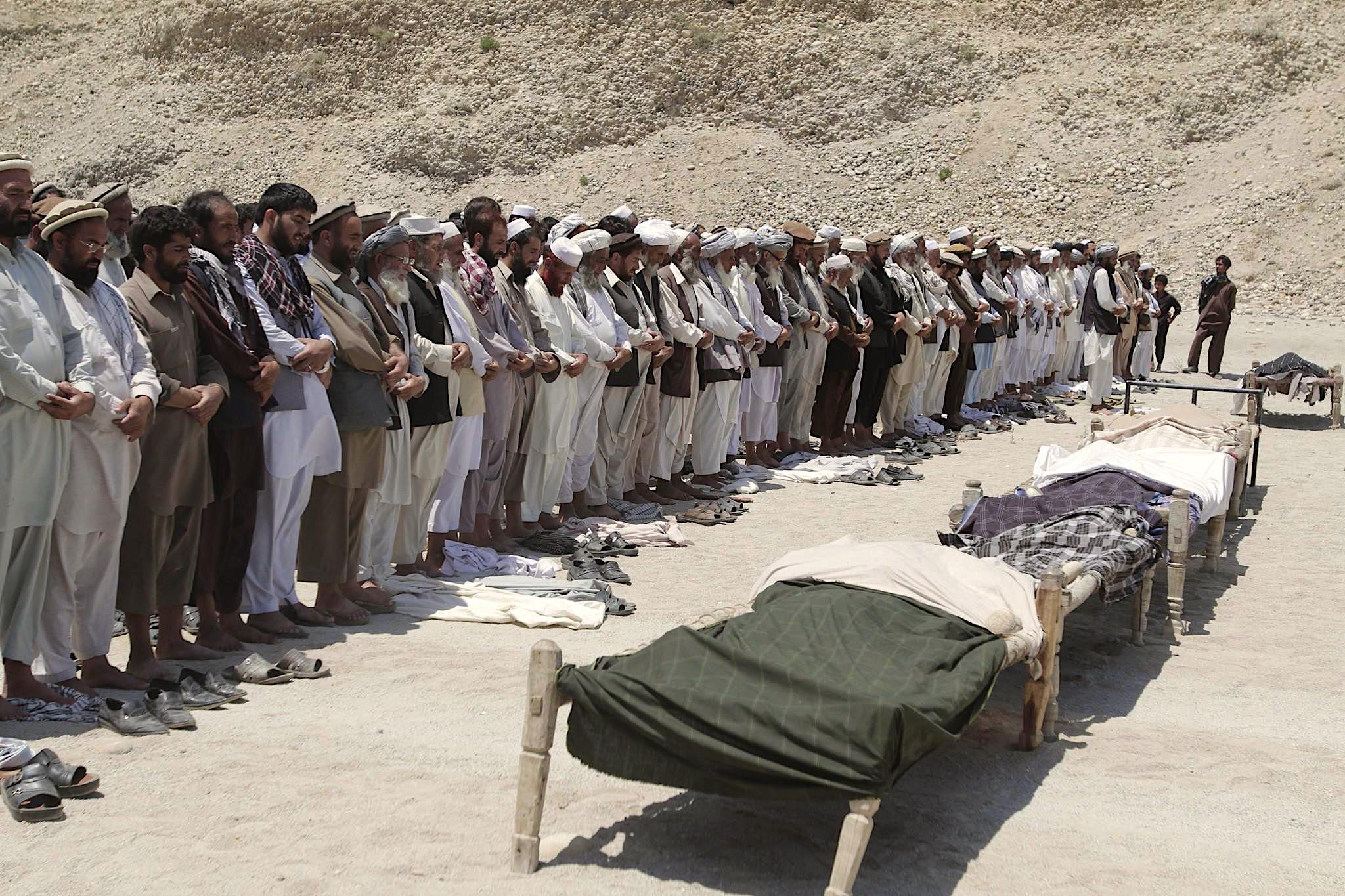
Burying civilians in Afghanistan. (Ariana News)
Around 15,000 U.S. forces, including soldiers and private contractors, have also died. Untold scores of devastating injuries have occurred as well to millions of civilians, opposition fighters, and American troops. In total, it’s estimated that, by 2020, these post-9/11 wars had cost American taxpayers $6.4 trillion.
While the overall number of U.S. military bases abroad may be in decline as the failure of the war on terror sinks in, the forever wars are likely to continue more covertly through Special Operations forces, private military contractors, and ongoing air strikes, whether in Iraq, Somalia, or elsewhere.
In Afghanistan, even when there were only 650 U.S. troops left, guarding the U.S. embassy in Kabul, the U.S. was still intensifying its air strikes in the country.
It launched a dozen in July alone, recently killing 18 civilians in Helmand province in southern Afghanistan. According to Secretary of Defense Lloyd Austin, attacks like these were being carried out from a base or bases in the Middle East equipped with “over the horizon capabilities,” supposedly located in the United Arab Emirates, or UAE and Qatar. In this period, Washington has also been seeking (as yet without success) to establish new bases in countries that neighbor Afghanistan for continued surveillance, reconnaissance, and potentially air strikes, including possibly leasing Russian military bases in Tajikistan.
And mind you, when it comes to the Middle East, the UAE and Qatar are just the beginning. There are U.S. military bases in every Persian Gulf country except Iran and Yemen: seven in Oman, three in the UAE, 11 in Saudi Arabia, seven in Qatar, 12 in Bahrain, 10 in Kuwait, and those six still in Iraq. Any of these could potentially contribute to the sorts of “over the horizon” wars the U.S. now seems committed to in countries like Iraq, just as its bases in Kenya and Djibouti are enabling it to launch air strikes in Somalia.
New Bases, New Wars
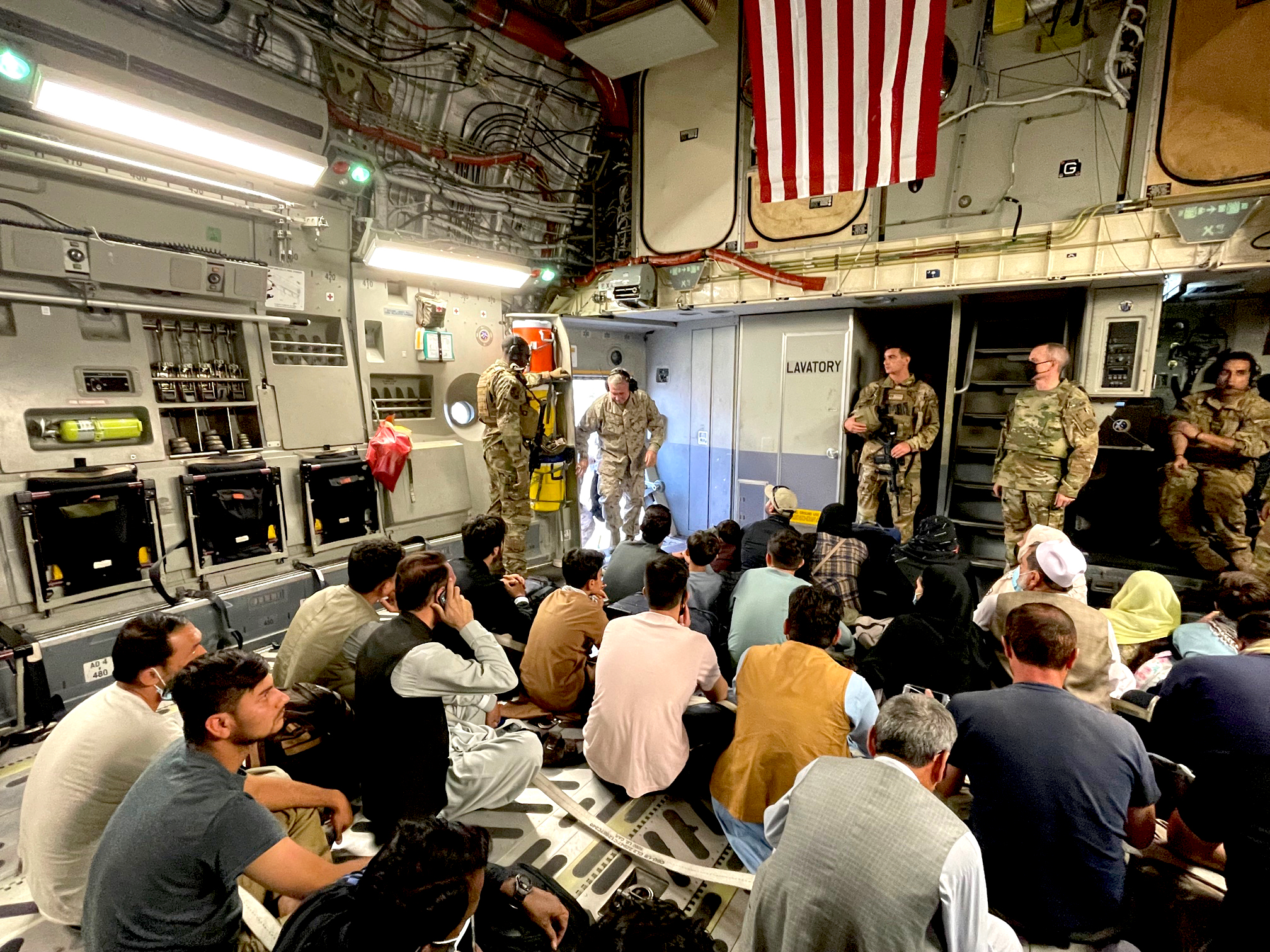
U.S. soldiers with Afghans evacuating Kabul on Aug. 17 after the Taliban captured Afghanistan’s capital city. (U.S. Navy, William Urban)
Meanwhile, halfway around the world, thanks in part to a growing push for a Cold War-style “containment” of China, new bases are being constructed in the Pacific.
There are, at best, minimal barriers in the United Sates to building military bases overseas. If Pentagon officials determine that a new $990 million base is needed in Guam to “enhance warfighting capabilities” in Washington’s pivot to Asia, there are few ways to prevent them from doing so.
Camp Blaz, the first Marine Corps base to be built on the Pacific Island of Guam since 1952, has been under construction since 2020 without the slightest pushback or debate over whether it was needed or not from policymakers and officials in Washington or among the American public. Even more new bases are being proposed for the nearby Pacific Islands of Palau, Tinian and Yap. On the other hand, a locally much-protested new base in Henoko on the Japanese island of Okinawa, the Futenma Replacement Facility, is “unlikely” ever to be completed.
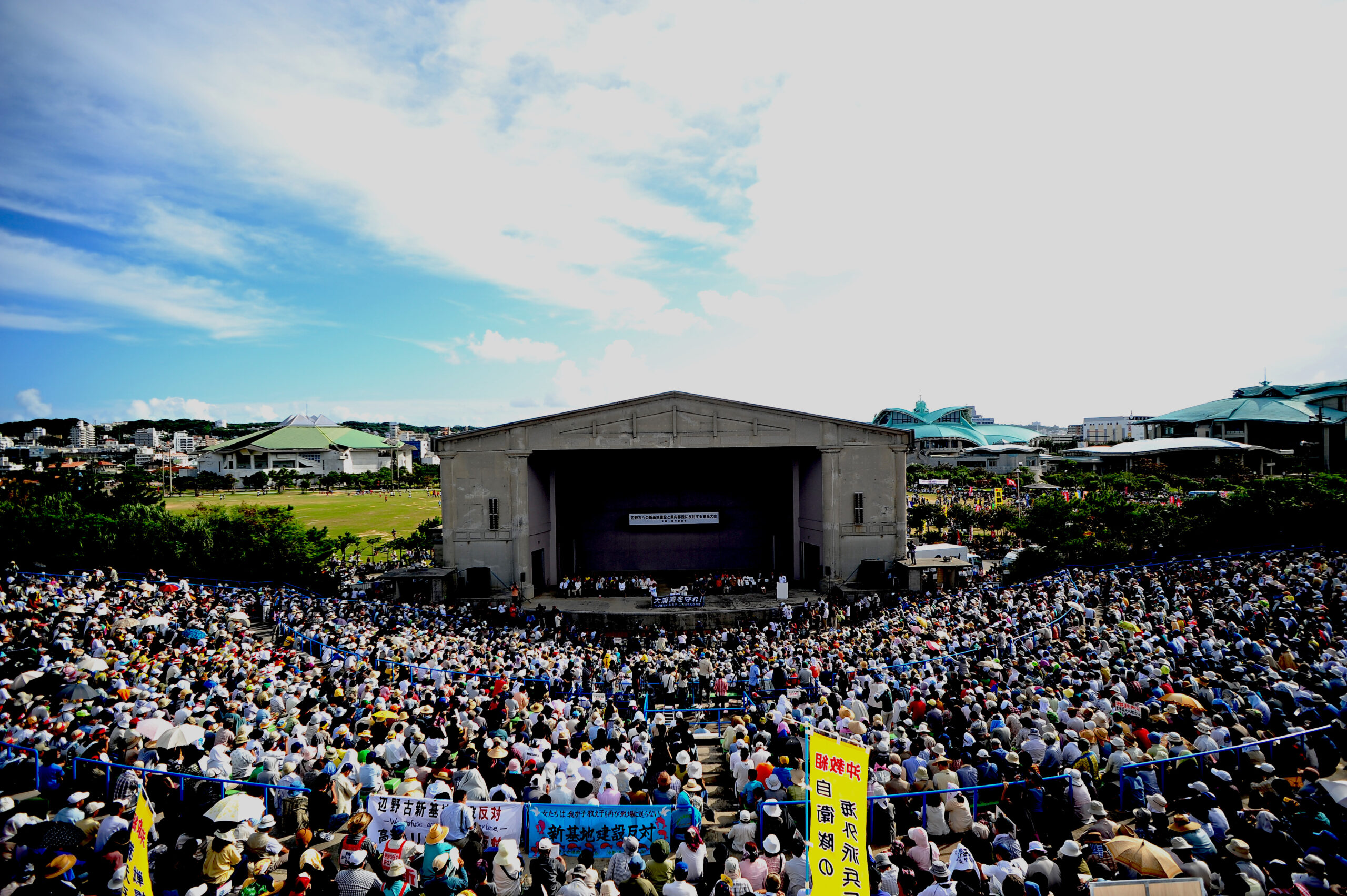
Nov. 8, 2009: Crowd protesting the Futenma base in Ginowan, Okinawa. (Nathan Keirn, CC BY-SA 2.0, Wikimedia Commons)
Little of any of this is even known in the United States, which is why a public list of the full extent of such bases, old and new, around the world is of importance, however difficult it may be to produce based on the patchy Pentagon record available. Not only can it show the far-reaching extent and changing nature of this country’s imperial efforts globally, it could also act as a tool for promoting future base closures in places like Guam and Japan, where there at present are 52 and 119 bases respectively — were the American public one day to seriously question where their tax dollars were really going and why.
Just as there’s very little standing in the way of the Pentagon constructing new bases overseas, there is essentially nothing preventing President Joe Biden from closing them.
As OBRACC points out, while there is a process involving congressional authorization for closing any domestic U.S. military base, no such authorization is needed abroad. Unfortunately, inside the U.S. there is as yet no significant movement for ending that Baseworld. Elsewhere, however, demands and protests aimed at shutting down such bases from Belgium to Guam, Japan to the United Kingdom — in nearly 40 countries all told — have taken place within the past few years.
In December 2020, however, even the highest-ranking U.S. military official, the chairman of the Joint Chiefs of Staff Mark Milley, asked: “Is every one of those [bases] absolutely positively necessary for the defense of the United States?”
In short, no. Anything but. Still, as of today, despite the modest decline in their numbers, the 750 or so that remain are likely to play a vital role in any continuation of Washington’s “forever wars,” while supporting the expansion of a new Cold War with China. As Chalmers Johnson warned in 2009, “Few empires of the past voluntarily gave up their dominions in order to remain independent, self-governing polities… If we do not learn from their examples, our decline and fall is foreordained.”
In the end, new bases only mean new wars and, as the last nearly 20 years have shown, that’s hardly a formula for success for American citizens or others around the world.
Patterson Deppen serves on the editorial board at E-International Relations where he is co-editor for student essays. A member of the Overseas Base Realignment and Closure Coalition, he recently completed research on the 750 U.S. military bases overseas in conjunction with World BEYOND War. The full listing of bases will appear in the future.
This article is from TomDispatch.com.
The views expressed are solely those of the author and may or may not reflect those of Consortium News.

A nation that was born in violence – a nation that will perish in violence.
NONE of these bases are for defense. The USA claims to be the victim of constant evil attacks requiring it to threaten, invade, attack, sanction anyone it “wants to”. If it decides it does not like the government, or certain groups inside any country, it unquestioningly acts and seems unable to be stopped. Legally the Congress should be the one to declare war, but this is rare. None of the claimed reasons for the attacks on Afghanistan, Iraq, Nicaragua, Venezuela , for example, are genuine, yet they happen again and again. Any excuse will do, and the compliant US media help the population to join joyfully in the “continuing success” which is always carefully tailored to sound fair and justifiable.
Why does the USA, unlike most other lands, never consider that they are allowed to live without telling everyone else how to live their lives? No cooperation (“allies” are bribed or forced) or even suggestion of understanding another point of view. No diplomacy-just “do as we order”. Assuming you are hated, then acting to ensure you really are or will be, is hardly the path to peace, harmony and prosperity.
It would be awesome to correlate the always hidden private us/UK enterprises behind the imperialistic colonization of sovereign nations… Coffee, sugar, cotton, oil – such correlations will help shine a light on the Shadow that is American republic: to *only* serve a few elite in the false name of democracy.
Thank you so much Mr. Deppen for your truly prescient timing with regard for the need for a response right now by The American People to the vacuous concept of Globalization (Empire). GWOT, a concept as repugnant as “The Patriot Act”, should become permanently attached to TMIC (The Military Industrial Complex) and thrown into the trash bin of Crimes Against Humanity…
Fortunately that time is at hand and I firmly believe that it’s time to revisit the concerns of Presidents Eisenhower and Kennedy (Presidents who both had personal experience with war and killing). I believe these topics will lead out thoughts in the immediate future and allow us here to come up with a much better approach…
This reads like the US military is an autonomous entity that coexists mainly as a parasite off the host country (the United States of America) that sustains it. Its main function seems to be total world domination regardless of what the government or citizens of that host country may think, want or do or where their essential interests lie. Things appear so out of whack to me that, more than anything, the relationship reminds me of that between a famous major football power and the university sponsoring that team which came to public attention when the president of the University of Oklahoma, one George L. Cross, was quoted as saying before the state assembly, from which he was requesting a not-well-received budget increase, that “We want to build a university that our football team can be proud of.”
The priorities and pecking order seem to be essentially the same in both symbiotic relationships. In both cases, the needs of the parasite are considered to be paramount over those of the host, and the interlocutors between them (the US Congress or the state assembly) instinctively recognise and acquiesce to this without the slightest hesitation. There is never any “power to the people” but only as much power for the powerful as they want. They get a blank check, they fill in the dollar amount and “We the People” sign it without even being told “thank you for the fruits of your labor.” “Better work harder and save more, we’ll be needing cash from you again later.” “Too bad your kid can’t afford college tuition, but maybe we can fit him with a uniform.”
I recently watched a PBS NOVA episode called “The Violence Paradox” in which it examined some guy named Steven Pinker and his theory that humans are getting more and more peaceful as the years unfurl. I totally disagree with it, I wonder if he ever was affected by any violence or unpleasantness up in his Harvard Ivory Tower. Just consider the mishandling of the pandemic, climate change horrors, the numerous millions of desperate folks displaced everyday from their homes, obviously these are kinds of violence to folks lives and “freedom” and their homes that just never get included in Pinker’s calculations and his “per capita” algorithms and such. And we need to consider that the cost of each of the 750 bases and wars and foreign entanglements is taking away needed money from essential services, creating more and more desperation and poverty. The growing income inequality is in so many ways a form of violence against the 99 percent, it’s against their will also in our democracy, or whatever our form of government is at this point. The military industrial complex has such a stranglehold on the minds of the West, that even Biden’s clumsy effort to draw it down is met with universal outrage and disbelief. I don’t know how in the hell we can get out of this paradox.
Aaron, professor Steven Pinker holds the Pangloss Chair at Harvard.
It is his job to proclaim this the very best of all possible worlds.
From his lofty perch, high up in the ivy covered ivory tower, on Olympus, things must look great, as nothing troubles his comfort or riles his concern (he hasn’t any, apparently).
However, he is much in demand among the shapers of public perception, as his narrative confirms both their merit and comfort with a status quo, concerned neither with justice or actual truth, but only with ensuring the protection of wealth, power, and privilege.
Yes, George Carlin did tell about this club, the Big Club, and (little) “we”, as Carlin reminded, “ain’t in it”.
Pinker’s job is to amuse and entertain the elite and their hangers on.
Not to honestly inform you and me about anything, and certainly not to confirm what our experience and lying eyes tell us.
> professor Steven Pinker holds the Pangloss Chair at Harvard.
Chuckle! I like it!